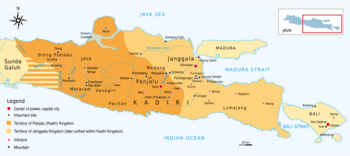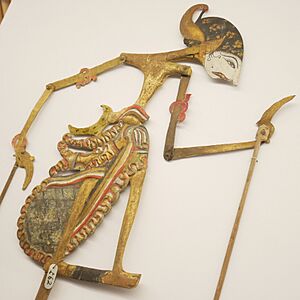Janggala facts for kids
Quick facts for kids
Janggala
|
|||||||||
|---|---|---|---|---|---|---|---|---|---|
| 1045–1136 | |||||||||

Janggala and Panjalu (Kediri) kingdom, later unified as Kediri kingdom
|
|||||||||
| Capital | Hujung Galuh (Surabaya) | ||||||||
| Common languages | Old Javanese, Sanskrit | ||||||||
| Religion | Kejawen, Hinduism, Buddhism, Animism | ||||||||
| Government | Monarchy | ||||||||
| Raja | |||||||||
| History | |||||||||
|
• Airlangga divided his kingdom into Janggala and Panjalu (Kediri)
|
1045 | ||||||||
|
• Kameswara of Kadiri married a princess of the Kingdom of Janggala, uniting the two
|
1136 | ||||||||
| Currency | Native gold and silver coins | ||||||||
|
|||||||||
The Kingdom of Janggala was an old kingdom on the island of Java. It was created in 1045 when King Airlangga decided to divide his large kingdom into two parts for his two sons. The other kingdom formed at that time was Kediri.
Janggala was located in the northeastern part of what used to be the Kingdom of Kahuripan. Not much is known about Janggala because Kediri became the more powerful kingdom. Eventually, Janggala and Kediri were joined back together.
What's in a Name?
The name Janggala likely came from "Hujung Galuh." In Old Javanese, this means "Cape Diamond" or "Cape Gemstone." Chinese records also mention a similar name, "Jung-ya-lu."
Hujung Galuh was an important port city. It was located where the Brantas River meets the sea, near today's Surabaya city. This port was very busy for trade and travel for many centuries. It was important during the time of Kahuripan, Janggala, Kediri, Singhasari, and Majapahit kingdoms.
Janggala and Kediri: A Family Story
King Airlangga was a very important ruler of the Mataram Kingdom in Java. Towards the end of his life, he made a big decision. He chose to divide his kingdom into two parts: Kadiri (also known as Kediri) and Janggala.
After dividing his kingdom, King Airlangga decided to step down from being king. He wanted to spend his time in quiet thought and meditation. This is similar to how a business owner might hand over their company to their children and then retire.
The western part of Airlangga's old kingdom became Kadiri. The eastern part became Janggala. About a hundred years later, the Kadiri kingdom grew stronger. Under the rule of King Jayabaya (1135-1157), Kadiri took control of Janggala. Kadiri also expanded its power to include areas like Bali and Kalimantan.
The two kingdoms, Kadiri and Janggala, were eventually reunited. This happened when Kameswara, the king of Kadiri (who ruled from 1116 to 1136), married a princess from the Kingdom of Janggala. After this marriage, the Kingdom of Janggala stopped existing as a separate kingdom.
Later, in 1222, the Kadiri kingdom itself was defeated. It was taken over by a neighboring state called Tumapel. This state was led by a powerful figure named Ken Angrok. So, Janggala was first absorbed by Kadiri, and then Kadiri was absorbed by Ken Angrok's new kingdom.
See also
- List of monarchs of Java


